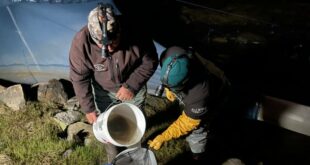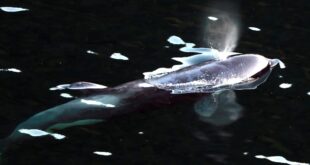The Cassini spacecraft discovered phosphates in Enceladus at least 100 times more concentrated than on Earth.

Another piece of evidence suggests life may be thriving beneath the icy surface of Saturn’s moon Enceladus. Phosphates have been discovered in the plumes of water ice escaping from the moon’s south pole.
Enceladus is one of several ice worlds orbiting the giant planets Jupiter and Saturn that are believed to have oceans of liquid water under thick layers of ice, which could harbour alien life.
In 2015, the Cassini spacecraft — which spent 13 years orbiting Saturn — discovered geysers erupting from cracks in the ice at the moon’s south pole. Water ice crystals and gas were gushing out into space at approximately 400 metres per second.
Some of that mineral-rich water ice dust feeds one of Saturn’s fainter outer rings — known as the E-ring — while most of it falls like snow back onto the moon’s surface, giving Enceladus its bright white colour.

Flying directly through the plume at the speed the spacecraft was going would have likely destroyed most of the organic compounds within the vapour. Instead, the spacecraft sampled the ejected material from Saturn’s E-ring.
Scientists at the Southwest Research Institute in Boulder, Colo., reported in the journal Nature that when they examined the data from Cassini’s Cosmic Dust Analyzer, they found the presence of sodium phosphates.
On Earth, phosphates are essential for all life. They are an integral part of DNA, cell membranes, chemical compounds that provide energy, and even your bones and teeth.
Finding phosphates in Saturn’s moon does not prove life is there. It’s just that one of the vital ingredients for life — that in Earth’s oceans controls the pace at which algae and aquatic plants are produced — is present. In fact, the research suggests the levels of phosphates inside Enceladus subsurface ocean are 100 times greater than in the oceans of Earth.

Earlier analysis of the Cassini data found the plumes also contain silica, ammonia, carbon dioxide and methane which are the same chemicals found at hydrothermal vents in the deep seas on Earth. These are regions where water that’s heated by the Earth interacts with and flows out of cracks in the ocean floor.
Ocean vents were first discovered in 1977 on the floor of the Pacific Ocean by Robert Ballard from the Woods Hole Oceanographic Institute. Ballard later went on to find the wreck of the Titanic. They were surprised to find an entire colony of unusual life forms thriving around the warm water.
In total darkness, under tremendous pressure, bacteria feed on the minerals in the water shooting out of the vents while larger filter feeders, such as clams, crabs and strange looking long, white tube worms, fed on the bacteria. It was an oasis of life, a self-contained ecosystem that did not depend on sunlight for energy.

If similar vents exist at the bottom of the ocean on Enceladus that we now know contain many of the ingredients required for life, could a similar kind of evolution happen there? The answer to that question will remain shrouded in mystery until another mission is sent to Enceladus to further explore what lies beneath the ice. So far, no such mission is planned.
However, a European mission called JUICE (Jupiter’s icy moons explorer) is currently on its way to Jupiter to explore the planet’s icy moons — Ganymede, Calisto and Europa, the latter of which is also believed to have an active water ocean, but with more water than all of the combined oceans on Earth.
Next year, NASA will follow with the Europa Clipper that will orbit the moon and look for conditions suitable for life.
The search for alien life is often focused on planets circling other stars that could be similar to Earth. But findings like these suggest there may be life much closer to home inside very un-earth-like moons concealing secrets under frozen blankets of ice.
ABOUT THE AUTHOR
Bob McDonald is the host of CBC Radio’s award-winning weekly science program, Quirks & Quarks. He is also a science commentator for CBC News Network and CBC-TV’s The National. He has received 12 honorary degrees and is an Officer of the Order of Canada.
*****
Credit belongs to : www.cbc.ca
 Atin Ito First Filipino Community Newspaper in Ontario
Atin Ito First Filipino Community Newspaper in Ontario







